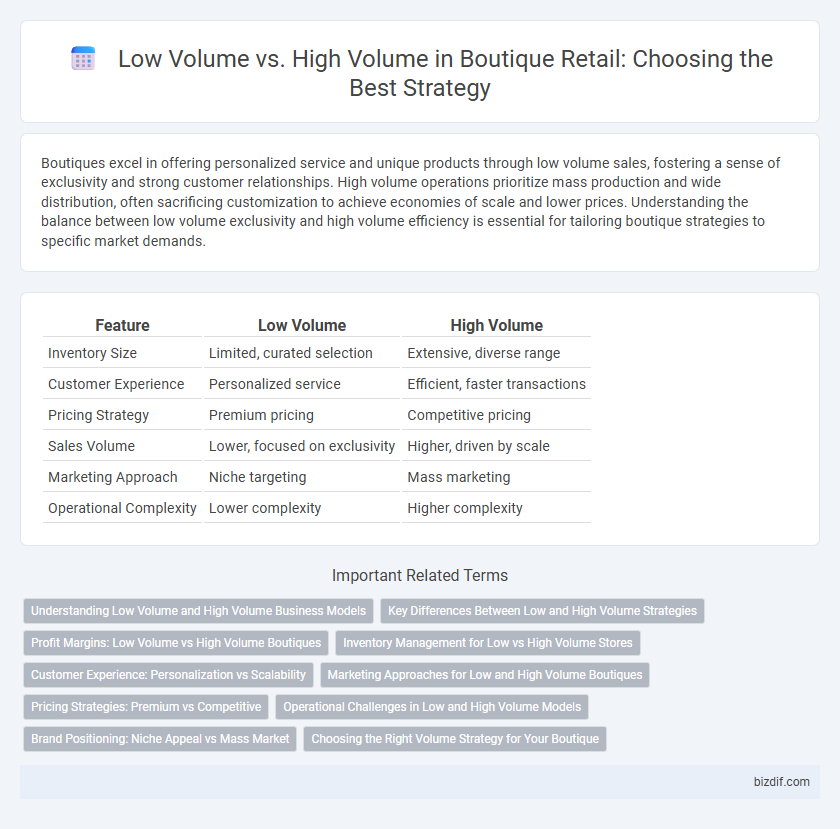Boutiques excel in offering personalized service and unique products through low volume sales, fostering a sense of exclusivity and strong customer relationships. High volume operations prioritize mass production and wide distribution, often sacrificing customization to achieve economies of scale and lower prices. Understanding the balance between low volume exclusivity and high volume efficiency is essential for tailoring boutique strategies to specific market demands.
Table of Comparison
| Feature | Low Volume | High Volume |
|---|---|---|
| Inventory Size | Limited, curated selection | Extensive, diverse range |
| Customer Experience | Personalized service | Efficient, faster transactions |
| Pricing Strategy | Premium pricing | Competitive pricing |
| Sales Volume | Lower, focused on exclusivity | Higher, driven by scale |
| Marketing Approach | Niche targeting | Mass marketing |
| Operational Complexity | Lower complexity | Higher complexity |
Understanding Low Volume and High Volume Business Models
Low volume business models in boutiques emphasize exclusivity and personalized customer experiences, often featuring handmade or limited-edition products that justify higher price points. High volume models prioritize mass production and wider distribution, focusing on scalability and lower costs to attract a larger customer base. Understanding these models helps boutique owners tailor their marketing strategies, inventory management, and brand positioning for optimal profitability.
Key Differences Between Low and High Volume Strategies
Low volume boutique strategies emphasize personalized customer experiences and exclusive product offerings, resulting in higher profit margins per item. High volume approaches rely on mass production and wider distribution to maximize overall sales and market reach, often sacrificing individuality for efficiency. Key differences include inventory management, pricing strategies, and customer engagement intensity, shaping distinct operational models in the boutique industry.
Profit Margins: Low Volume vs High Volume Boutiques
Low volume boutiques often achieve higher profit margins by focusing on exclusive, high-quality products with premium pricing strategies. High volume boutiques, while generating more sales, typically operate on thinner margins due to discounts and competitive pricing to attract a larger customer base. Profit optimization in boutiques depends on balancing inventory turnover and pricing models tailored to target market segments.
Inventory Management for Low vs High Volume Stores
Inventory management in low volume boutiques prioritizes precision and flexibility, ensuring limited stock reflects curated selections that match niche customer preferences. High volume stores emphasize efficient turnover and automation, leveraging bulk purchasing and real-time stock tracking to handle large quantities and diverse product ranges. Tailoring inventory strategies to transaction frequency and consumer behavior optimizes profitability and reduces overstock risks.
Customer Experience: Personalization vs Scalability
Low volume boutique operations prioritize personalized customer experiences by offering tailored products and one-on-one service that enhance individual satisfaction and brand loyalty. High volume boutiques focus on scalability, using efficient processes and technology to serve a larger customer base while maintaining consistent quality and faster turnaround times. Balancing personalization with scalability is essential for boutiques aiming to optimize customer engagement and operational growth.
Marketing Approaches for Low and High Volume Boutiques
Low volume boutiques benefit from personalized marketing strategies emphasizing exclusivity, tailored customer experiences, and niche targeting to build strong brand loyalty. High volume boutiques require scalable marketing approaches leveraging data-driven campaigns, broad social media outreach, and promotions to attract a wider audience and drive mass sales. Optimizing marketing for each volume type enhances customer engagement and maximizes revenue potential in boutique businesses.
Pricing Strategies: Premium vs Competitive
Boutique retailers with low volume sales often adopt premium pricing strategies to emphasize exclusivity and superior quality, attracting discerning customers willing to pay more for unique products. High volume boutiques typically implement competitive pricing to drive larger sales volumes and reach broader market segments while maintaining profitability through economies of scale. Pricing strategies in boutiques must balance product exclusivity with market demand to optimize revenue and customer perceptions.
Operational Challenges in Low and High Volume Models
Low volume boutique operations face challenges such as higher per-unit costs, limited economies of scale, and greater reliance on specialized craftsmanship, which can strain resources and extend production timelines. In contrast, high volume models encounter difficulties in maintaining product quality, managing supply chain complexity, and ensuring consistent customer experiences across large batches. Both models require tailored operational strategies to balance efficiency, scalability, and brand integrity in a competitive market.
Brand Positioning: Niche Appeal vs Mass Market
Low volume production in boutiques enhances brand positioning by cultivating a niche appeal that emphasizes exclusivity and craftsmanship, attracting discerning customers seeking unique, high-quality products. High volume production targets the mass market, prioritizing affordability and widespread availability, which may dilute brand uniqueness but drives larger sales volumes. Boutique brands must strategically balance exclusivity with scalability to maintain brand integrity while expanding market reach.
Choosing the Right Volume Strategy for Your Boutique
Selecting the right volume strategy for your boutique depends on target customer demand and inventory management capabilities. Low volume strategies emphasize exclusivity and personalized customer experience, ideal for luxury or niche markets, while high volume approaches prioritize greater sales and turnover, suitable for fast fashion or mass-market products. Analyzing sales data and market trends can help tailor the volume strategy to optimize profitability and brand positioning.
Low Volume vs High Volume Infographic

 bizdif.com
bizdif.com